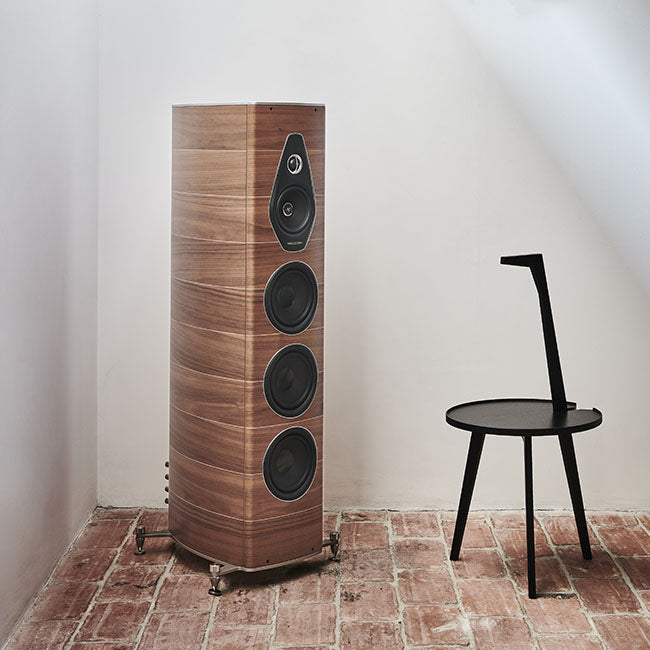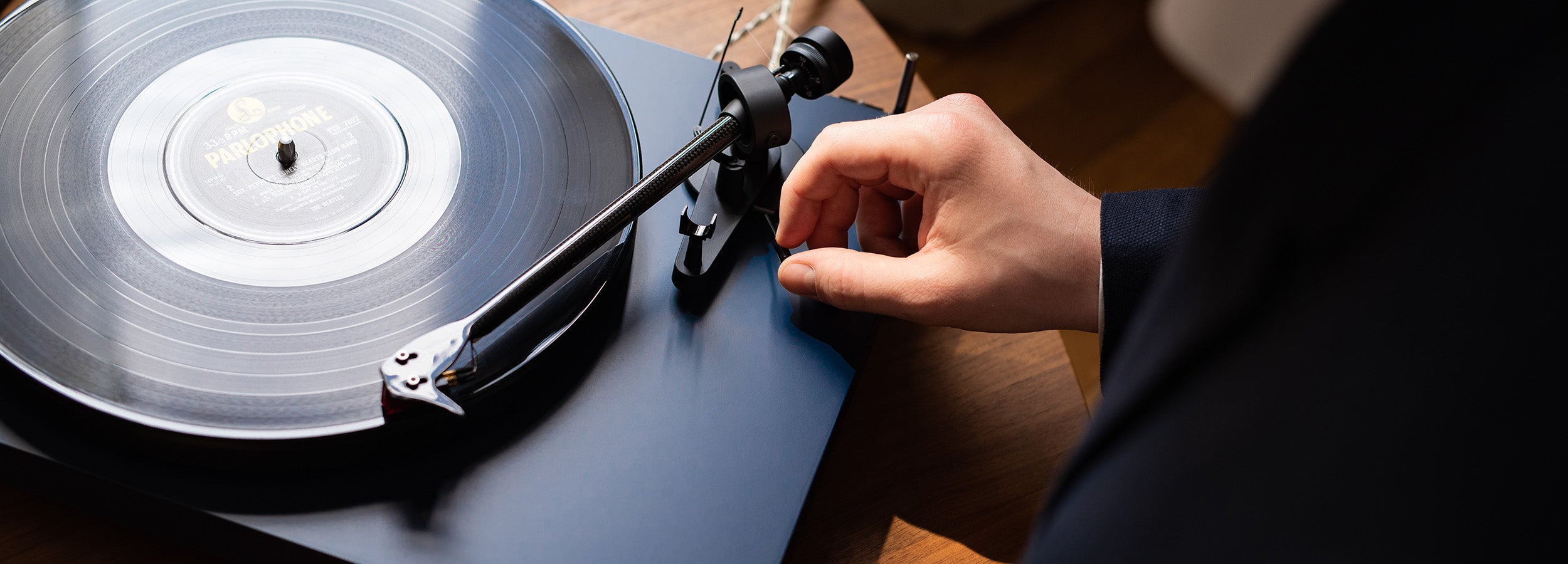The record player is as popular as ever, and for good reason. An incredible amount has happened since the first record player, which was called the Phonograph and was invented by Thomas Edison in 1877. Back then, the record player made a mechanical playback of a record made of asbestos and shellac, and the sound went from the pickup into a funnel that acted speaker. The recording went the other way, where the music was recorded by the funnel, which sent the music down into a cutting needle, which made the grooves that were later to be played.
Fast forward to today, where turntables sound better than ever, are easier to get started with, and the records are now made entirely of harmless vinyl. The playing of the groove is the same, but the movements of the pickup now become current, which is made in the pickup and sent to an amplifier. The sound reproduction is thus so good that it is perceived by many as the best.

This is how you get started
You can start with a record player for DKK 3,000 and get a really nice all-round reproduction and an easy set-up and easy operation. Some expensive turntables depend on you having experience and skill in setting up, as they almost come as a kit, where you can make the adjustment yourself, with a headlamp, a wet newspaper and a ruler. But you can also choose a top turntable from one of the manufacturers who have the expertise and equipment to deliver the turntable adjusted exactly as it should be. The days when turntables were complicated are over.
Why should I buy a record player?
A good quality record player can deliver a sound you rarely hear on sources such as streaming or CD. The record player has a completely characteristic warm and analogue sound, and therefore you will often find that the brain relaxes and you get a different and better experience of the music. The record player is also a faithful and reliable player that does not depend on the internet, bluetooth connection or other black magic over which we have no power. The record player plays when you lower the pickup onto the record, quite simply.
With a record player, you can also dive into millions of LPs from when the music was in original master quality and not copied. The fact that the LPs can be obtained for modest money today, and that LPs are still being published, all contribute to making the record player a contemporary and attractive music player.
Finally, there is the concept of focus. Today, we can both watch TV and listen to music through all kinds of streaming devices, and yet we do not "hear" the music. It just plays out there in a steady stream, regardless of whether we are exercising, cooking or sleeping. The record player, on the other hand, demands your attention, and just the fact that you have to find the record and put it on the record player is often enough to get you into a state of calm and focus, which is necessary for you to get the full experience of what the musicians wanted with the music.

Ortofon Quintet Blue Mc

Rega Rb-330 Tonearm

Rega planar 8 record player
Which turntable should I choose?
You can get an excellent record player for DKK 3,000, just as you can get record players at absurd prices. Basically, the difference between cheap and expensive turntables should be that the more expensive they get, the more accurate, quieter and better playing they are. And precision is important when operating with groove movements down to a few thousandths of a millimeter.
There is a free choice between "plug and play" solutions, where the manufacturer has installed a pickup, or assemble solutions yourself, where it is required that you know what to do when the record player needs to be set up. Get advice from us before you buy, so that you get the right one for your plant and your needs.
What is the difference between an expensive and cheap record player?
Typically, it will be a better tonearm, a better motor, a better platter and a better plinth. Better will mean less blur, less noise, higher precision, all to read the record without affecting the sound with negatives such as distortion and poor stability. An expensive record player is not necessarily better than a cheap one, which makes it wise to have them demonstrated in the store. Within a brand, however, one must assume that the most expensive is the best.
A rule to remember is that the more automatic for a given price, the worse sound you get, compared to a manual record player in the same price range.
Turntables for all needs

Pickups - Spoil your record player
If you want to lift the sound from your record player, a new pickup can do wonders. A pickup is the small "lump" that must sit at the tip of the tone arm. The pickup housing is typically made of metal, plastic or wood and functions as a wrapper for the interior that generates the sound. Mainly there are 2 groups of pickups, namely MM (moving magnet) and MC (moving coil).
Moving magnets will be the cheapest as they are less demanding to assemble. MC pickups will therefore be in price ranges that require a better record player. Typically, turntables in the price range NOK 3,000-15,000 will be/will be equipped with an MM pickup and more expensive turntables with MC pickups. There are exceptions and it pays well, when investing in a record player, to buy as good a record player as the economy allows and then save a little on the pickup, since it will have to be replaced at some point anyway.
The price differences on pickups are often due to the fact that the grinds on the small diamond at the end of the needle tube are different. The finer the diamond is cut, the better (more precisely) it reads the groove and gets information that the more primitive cuts will have trouble with.
Pickups

The RIAA amplifier - an absolute must
In order to be able to play a record at all and get the music out of the speakers, you must have a preamplifier which, in this context, is called an RIAA amplifier. It has two functions, one is to amplify the very weak signal coming to the pickup, the other is to correct the frequency curve.
The correction is necessary because, when the record is cut, you have to lower the bass (otherwise the pickup will jump out of the groove) and raise the treble (to remove hiss and noise later when it is lowered again). With these measures in the cutting process, it is of course necessary to correct the sound before it can be played with good results, and that is exactly what an RIAA does, it restores the frequency curve and amplifies the signal. Many amplifiers have built-in RIAA and such an input is typically called "phono".
If you do not have a built-in RIAA in the amplifier, it can be purchased separately and connected to a regular line input on the amplifier, e.g. CD, AUX, TUNER. An outstanding MM-Riaa can be acquired for approx. DKK 1000, whereas an MC-Riaa costs quite a bit more and works in the same way, apart from its even stronger amplification. This is because an MC pickup typically has a much weaker output signal to send into the RIAA part, and therefore the signal requires a stronger amplification.
RIAA amplifiers
FAQ about turntables
Yes, we ship all over the world. Shipping costs will apply, and will be added at checkout. We run discounts and promotions all year, so stay tuned for exclusive deals.
It depends on where you are. Orders processed here will take 5-7 business days to arrive. Overseas deliveries can take anywhere from 7-16 days. Delivery details will be provided in your confirmation email.
You can contact us through our contact page! We will be happy to assist you.
Write a clear and concise answer to guide your customers.
Write a clear and concise answer to guide your customers.
Accessories for the record player

Pickups for every need
Pair text with an image to focus on your chosen product, collection, or blog post. Add details on availability, style, or even provide a review.

High quality RIAA amplifier
Pair text with an image to focus on your chosen product, collection, or blog post. Add details on availability, style, or even provide a review.

Maintain your turntable
Pair text with an image to focus on your chosen product, collection, or blog post. Add details on availability, style, or even provide a review.
























